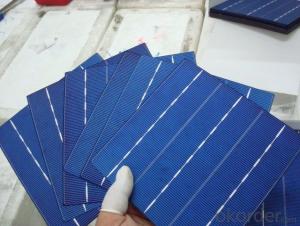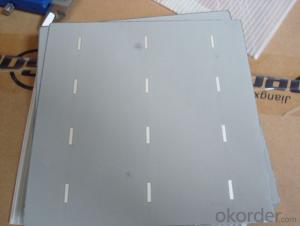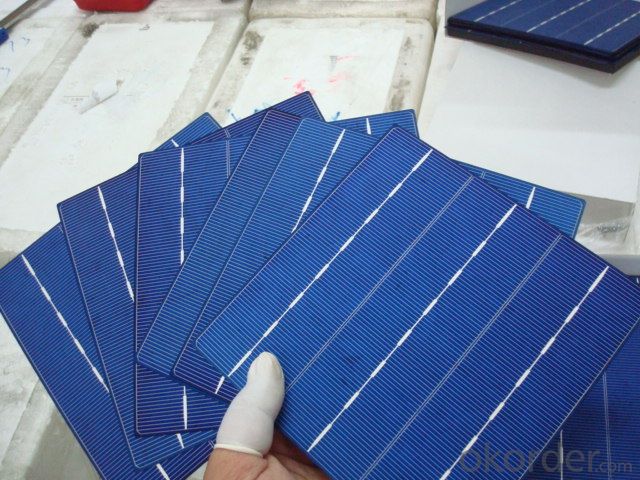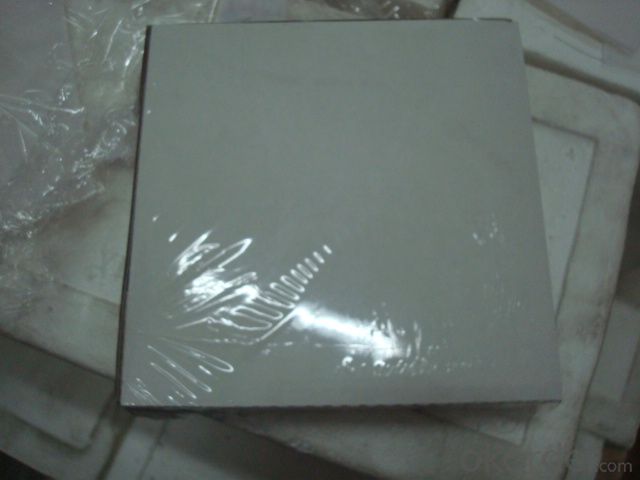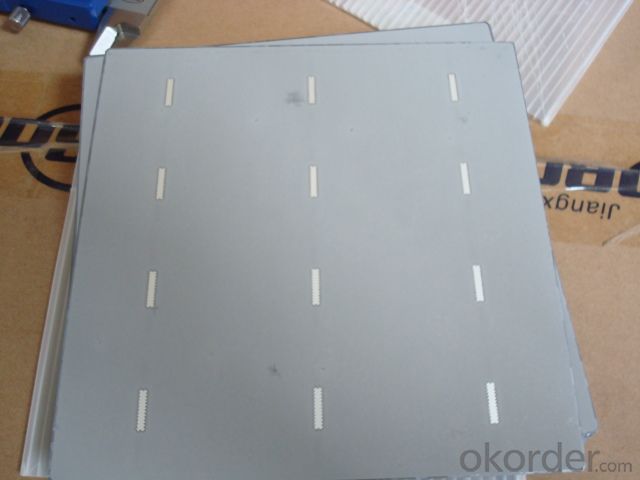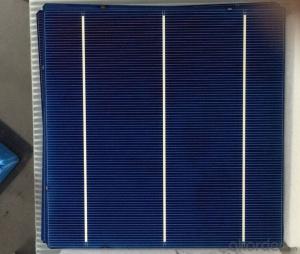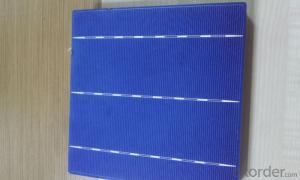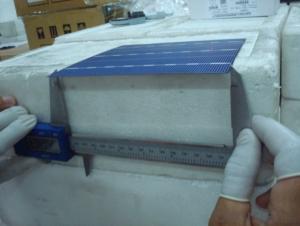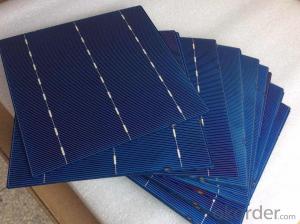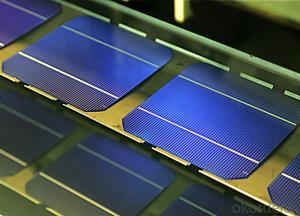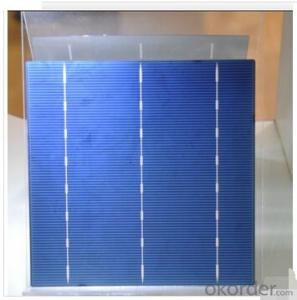Solar Cells Hellas - Polycrystalline Solar Cells Tire 1 Manufacturer -16.6%
- Loading Port:
- Shanghai
- Payment Terms:
- TT OR LC
- Min Order Qty:
- 10000 pc
- Supply Capability:
- 50000000 pc/month
OKorder Service Pledge
OKorder Financial Service
You Might Also Like
Brief Introduction of Solar Cells
A solar cell is a fabricated device that converts the sun’s light into electricity. If we want to get right into it, a solar cell takes the energy from the sun’s light rays, by using the colliding light at the photon level to split apart the electron-hole pairs. When the photon hits the pair, they break, and one part goes north one part south. The stronger the sun, the quicker and more this happens. This process is called the photoelectric effect. The following diagram explains.
Specifications of Polycrystalline Solar Cells
Format : 156 mm × 156 mm ± 0.5 mm
Thickness: 210 μm ±40 μm
Front (-) : 1.5mm bus bars (silver),blue anti-reflection coating (silicon nitride)
Back (+) : 2.5mm wide soldering pads (silver) back surface field (aluminium)
Efficiency (%) | Pmpp (W) | Umpp (V) | Impp (A) | Voc (V) | Isc (A) |
18.00% | 4.38 | 0.528 | 8.291 | 0.631 | 8.869 |
17.80% | 4.33 | 0.525 | 8.252 | 0.629 | 8.821 |
17.60% | 4.29 | 0.532 | 8.053 | 0.633 | 8.541 |
17.40% | 4.23 | 0.528 | 8.092 | 0.624 | 8.632 |
17.20% | 4.19 | 0.524 | 7.992 | 0.62 | 8.458 |
17.00% | 4.14 | 0.52 | 7.972 | 0.623 | 8.5 |
Advantage of Polycrystalline Solar Cells
High conversion efficiencies resulting in superior power output performance.
Suitable for keeping appearance of solar cell tidy and clean.
Advanced diffusion technology adapted to ensure conversion efficiency uniformity throughout cell.
Advanced PECVD film forming technology used to coat cells with dark blue silicon nitride anti-reflection coatings.
Uniform color appearance.
Advanced soft line and high precision silkscreen printing equipment to achieve high smoothness, make automatic welding and laser cutting easier.
Metal paste applied to making back surface field and electrode to ensure top conductivity, nice adhesion, superior weld-ability, nice appearance and reliable performance.
Efficiency, stability and durability of crystal silicon.
Low breakage rate.
Environmental protection.
OEM orders are welcome
Usage of Polycrystalline Solar Cells
Solar cells are often electrically connected and encapsulated as a module. Photovoltaic modules often have a sheet of glass on the front (sun up) side, allowing light to pass while protecting the semiconductor wafers from abrasion and impact due to wind-driven debris, rain, hail, etc. Solar cells are also usually connected in series in modules, creating an additive voltage. Connecting cells in parallel will yield a higher current; our solar cells have passed IEC Certification. With high and stable quality, our cells can greatly improve the performance of Solar Modules.
Applications of Polycrystalline Solar Cells
Assemblies of photovoltaic cells are used to make solar modules which generate electrical power from sunlight, as distinguished from a "solar module" or "solar panel". A solar array generates solar power using solar energy.
Packaging & Delivery of Polycrystalline Solar Cells
Carton Box Package and Deliver by air. It should be noticed that it should be avoid of water, sunshine and moist.
Factory Picture of Solar Cells
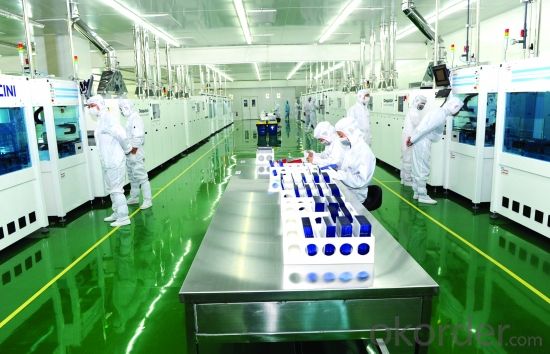
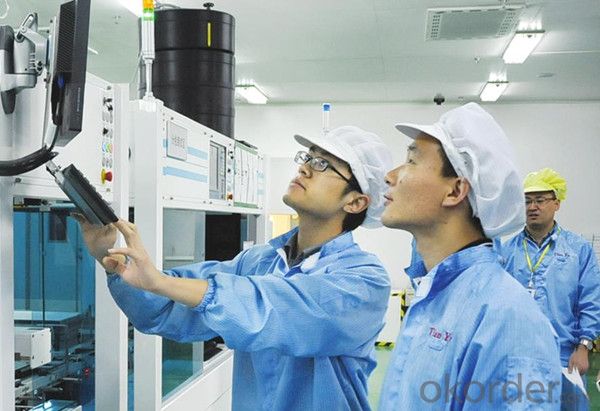
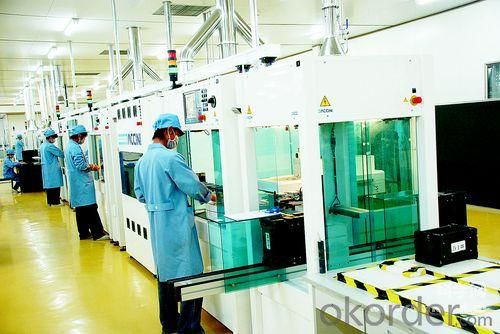
We have organized several common questions for our clients,may help you sincerely:
1. What’s price per watt?
A: It’s depends on the quantity, delivery date and payment terms of the order. We can talk further about the detail price issue. Our products is high quality with lower price level.
2. Can you tell me the parameter of your solar cells?
We have different series of cells with different power output, both from c-si to a-si. Please take our specification sheet for your reference.
3. How do you pack your products?
We have rich experience on how to pack the panels to make sure the safety on shipment when it arrives at the destination.
4. Can you do OEM for us?
Yes, we can.
5. How long can we receive the product after purchase?
In the purchase of product within three working days, We will arrange the factory delivery as soon as possible. The perfect time of receiving is related to the state and position of customers. Commonly 7 to 10 working days can be served.
- Q: Can solar cells be used for indoor lighting?
- Yes, solar cells can be used for indoor lighting. However, they are generally less efficient indoors compared to outdoor environments due to the reduced amount of sunlight available. Additionally, indoor lighting usually requires a constant and reliable power source, which may be challenging to achieve solely through solar cells.
- Q: Are solar cells affected by extreme temperatures?
- Yes, solar cells are indeed affected by extreme temperatures. High temperatures can cause solar cells to degrade and operate less efficiently, resulting in a decrease in power output. Similarly, extremely low temperatures can also reduce the performance of solar cells, although to a lesser extent. Therefore, it is important to consider temperature conditions when designing and installing solar panels to optimize their performance and longevity.
- Q: Can solar cells be used in military applications?
- Yes, solar cells can be used in military applications. They have various applications in the military, including powering remote surveillance systems, communication equipment, and providing electricity to field operations in remote areas. Solar cells offer a reliable and sustainable source of energy, reducing the reliance on traditional fuel sources and enhancing the operational efficiency of military units. Additionally, solar technology can be integrated into portable and lightweight systems, improving mobility and reducing the logistical burden for military personnel.
- Q: How do solar cells affect the grid?
- Solar cells affect the grid by generating electricity from sunlight and feeding it into the grid. This has the potential to reduce the demand for electricity from traditional sources, lower carbon emissions, and contribute to a more sustainable and decentralized energy system. However, the intermittent nature of solar power can also pose challenges for grid stability and require the integration of energy storage and smart grid technologies.
- Q: Can solar cells be used to power outdoor lighting systems?
- Yes, solar cells can be used to power outdoor lighting systems. Solar cells, also known as photovoltaic cells, convert sunlight into electricity. This electricity can be stored in batteries or used directly to power outdoor lighting systems, eliminating the need for traditional electrical wiring or reliance on grid electricity. Solar-powered outdoor lighting systems are efficient, cost-effective, and environmentally friendly solutions for illuminating outdoor spaces.
- Q: How do solar cells perform in different geographical locations?
- Solar cells perform differently in different geographical locations due to variations in sunlight intensity, duration, and angle of incidence. Geographical factors like latitude, climate, cloud cover, and air pollution affect the performance of solar cells. Regions closer to the equator generally receive more direct sunlight, resulting in higher energy generation. However, solar cells can still perform well in regions with less sunlight, as advancements in technology have improved their efficiency. Additionally, solar cells can be optimized for specific geographical locations by adjusting their tilt, orientation, and tracking systems to maximize energy production.
- Q: Can solar cells be used for powering security systems?
- Yes, solar cells can be used for powering security systems. Solar cells are capable of converting sunlight into electricity, providing a sustainable and renewable energy source for various applications, including security systems. By harnessing solar power, security systems can operate independently from the grid, making them more reliable and cost-effective in remote or off-grid locations. Additionally, solar-powered security systems are environmentally friendly, reducing carbon emissions and minimizing reliance on fossil fuels.
- Q: How does the size of a solar cell affect its performance?
- The size of a solar cell directly affects its performance. Generally, larger solar cells have the ability to generate more electricity compared to smaller ones. This is because larger cells have a greater surface area to capture sunlight, resulting in a higher conversion efficiency and increased power output. Additionally, larger cells are better at handling heat dissipation, which can improve their overall performance and durability.
- Q: Can solar cells power an entire house?
- Yes, solar cells can power an entire house. With advancements in technology, solar cells are becoming more efficient and affordable. By installing a sufficient number of solar panels on the roof of a house, it is possible to generate enough electricity to meet the energy needs of the entire household, including powering appliances, lighting, heating, and cooling systems. Additionally, excess energy can be stored in battery systems or fed back into the grid for use during cloudy days or at night.
- Q: What is the maximum efficiency that a solar cell can achieve?
- The maximum efficiency that a solar cell can achieve is known as the Shockley-Queisser limit, which is approximately 33.7%. However, in practical applications, commercial solar cells typically have efficiencies ranging from 15% to 22%.
Send your message to us
Solar Cells Hellas - Polycrystalline Solar Cells Tire 1 Manufacturer -16.6%
- Loading Port:
- Shanghai
- Payment Terms:
- TT OR LC
- Min Order Qty:
- 10000 pc
- Supply Capability:
- 50000000 pc/month
OKorder Service Pledge
OKorder Financial Service
Similar products
Hot products
Hot Searches
Related keywords
